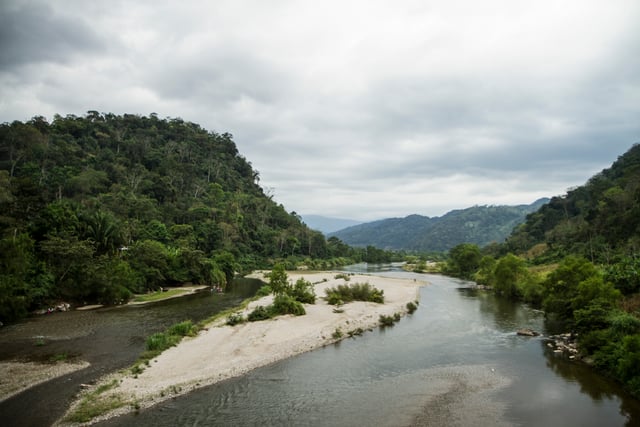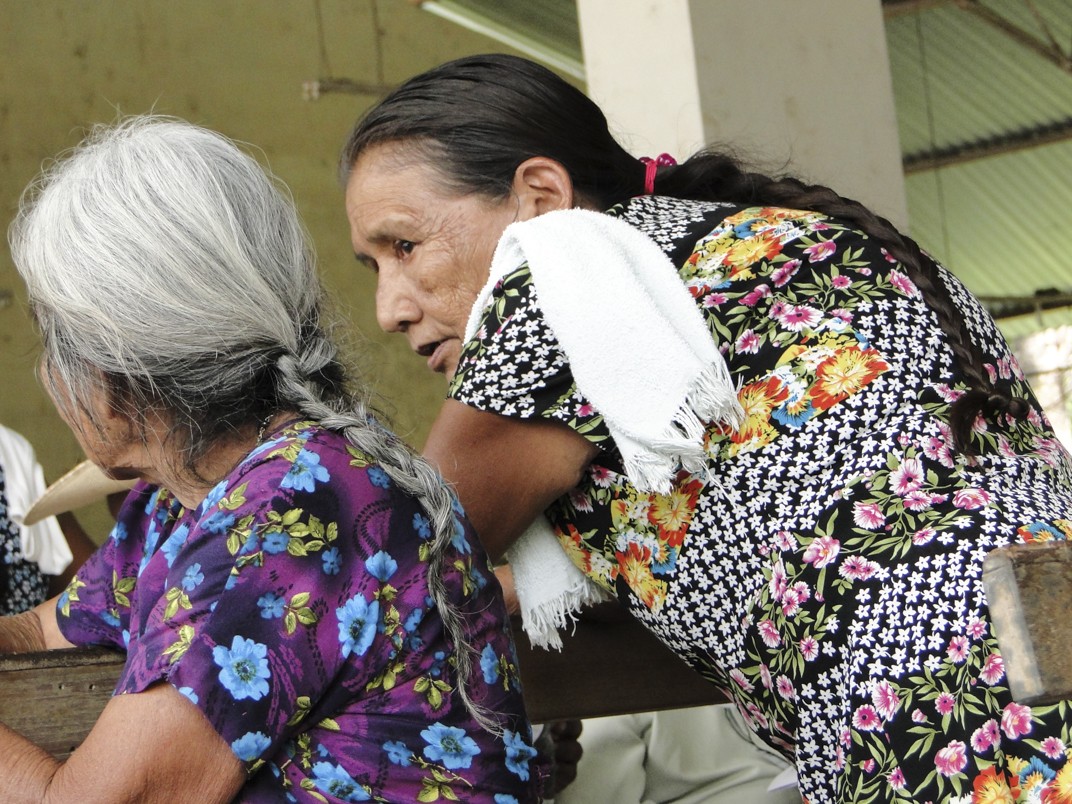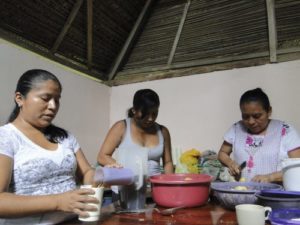Filed under: Analysis, Environment, Featured, Indigenous, Mexico, Southern Mexico

By Renata Bessi and Santiago Navarro F
The Chinantec people, inhabitants of the Cajonos River basin in the north of the state of Oaxaca, Mexico, are carrying out an organizational process throughout their entire territory, the Chinantla, against economic projects that seek to commodify nature as a whole. They are megaprojects such as mining, hydroelectric dams, highways, conservation projects, and, more recently, hydrocarbons. It is not a coincidence Chinantla is considered a priority of economic interest for the Mexican government. It houses the third largest tropical rainforest in Mexico. After the Lacandona jungle in Chiapas, and the Chimalapas in Oaxaca, it is the best preserved and one of the richest in biodiversity.
 “The Chinantla is a priority area for exploitation because of its wealth, its diversity. It’s part of a strategic Mesoamerican plan that comprises all that is Veracruz, the Chinantla zone, Chiapas and Central America in the so-called Plan Mérida and Mesoamerica Project. The objective of the Mexican government and businesses is to create a corridor for the exploitation of water, minerals, coal reserves, and electricity-generating projects. Here are the plants, bacteria, mushrooms that heal and these are all things they also want to take away,” explained biologist Patricia Mora, from the Interdisciplinary Research Center for Integral Regional Development – Oaxaca Unit of the National Polytechnic Institute (CIIDIR Oaxaca).
“The Chinantla is a priority area for exploitation because of its wealth, its diversity. It’s part of a strategic Mesoamerican plan that comprises all that is Veracruz, the Chinantla zone, Chiapas and Central America in the so-called Plan Mérida and Mesoamerica Project. The objective of the Mexican government and businesses is to create a corridor for the exploitation of water, minerals, coal reserves, and electricity-generating projects. Here are the plants, bacteria, mushrooms that heal and these are all things they also want to take away,” explained biologist Patricia Mora, from the Interdisciplinary Research Center for Integral Regional Development – Oaxaca Unit of the National Polytechnic Institute (CIIDIR Oaxaca).
So much diversity has been in the hands of the Chinantec even before colonization by the Spanish. They resisted with their language and their culture against the Spanish and domination by the Aztecs, and now they are organizing against the wave of exploitation by multinationals in their territory. “In our hands is the wealth that the businesses want, which is why they want us to disappear,” argues Jacinto Flores, an inhabitant of the region and organizing member of the National Indigenous Congress (CNI) and the Chinantec Kia Nan Indigenous Force of the Papaloapan Basin.
In the middle of April, the community of Santo Antonio las Palmas, in the municipality of Choapam, set up a space where the communities could discuss the problems they are experiencing with the megaprojects, as well as organizing strategies to fight together. It is the Forum Against Dispossession and Repression, that had its first iteration on April 9 and 10, called for by the CNI in the Papaloapan region.
“We alone cannot face this clash. If we the peoples do not unite, if we do not join together, we will be immersed in slavery or death. If they start, for example, opening mining projects and fracking wells – Mexico must open 20,000 fracking wells – we’ll arrive at the disappearance of the original peoples. There is no other path. We have to organize on a national level, international, to bring the struggle together on a national and international level. Globalize the struggle,” asserts Flores.
In 1997, federal and state institutions, among them the Environment and Natural Resources Ministry (SEMARNAT), began negotiations with the Global Environmental Facility (GEF), to conduct research in the Chinantla region with respect to its natural resources. Flores asserts that they took an inventory of the mountains, basins, water reservoirs, minerals, animals, edible plants, healing plants, and ornamental plants. “And when they finished their research, which was believed to be for the people, but in the end they were studying what was feasible for the world market.” The objective became clear for the communities years later with the arrival in the territory of the first projects for the commercialization of the water, coal and genetic materials.
There is a project by the Mexican government to conserve about 260,000 hectares of mountains in the region, says Flores. “It is a deception that they are trying to spread that the conservation is for the people. The government is conserving the mountains at the same time it’s putting them up for auction, to see who will pay the most for them. Here we have 13 Chinantec tourist corridors, that’s where the conservation areas are. They’re turning us into criminals on our own territory. We can’t enter the mountains, we can’t draw water that is ours, if so, we are committing a crime.”
At the same time they are taking away the people’s right to subsist off the mountain through conservation projects, the government grants land for mineral exploration by multinationals. In the San Vicente Arroyo Jabali community, for example, they are going to open a mine that contains gold, silver, copper and zinc. In 2008, a company arrived with documents prepared for the people to sign so the mine could open. “They have the deeds ready, prepared. The document talked about a 50 year concession. Close to 26,400 hectares of land span the mine. We resisted and the people of Jabali issued a decision that they would not accept the opening of the mine. They wanted to put the reserve there, but they did not accomplish it, the people of Jabali continue to resist.”
Water, essential for life and increasingly scarce in Mexico, is not lacking in Chinantla, one of the regions in the country with great rainfall. But it is also up for sale. “In the Zuzul region, ejido Vega del Sol, in the municipality of Santa Maria Jacatepec, Pepsi-Cola bought a natural water deposit in the town. In the Naranjal, there is a waterfall that belongs to that town that was bought by Coca-Cola. And the brewers of Modelo are taking ownership of the rivers,” said Flores.
In the lower part of Chinantla, part of the land was leased to a Canadian company associated with the Sabritas company, explains Flores. “In the land, that is community-owned, they are sowing taro, a big sweet potato, so they could utilize them for their Sabritas products. We know that this is just a small step, but after the leasing of the land comes the total dispossession of the rural farmer.”
The exploitation of hydrocarbons is also projected in this region by the federal government, mainly fracking. “Some authorities are already signing projects concerning the exploitation of hydrocarbons. The people do not know what this is all about, they are not being informed. The institutions come and they make them sign contracts, they come with promises, with deception”, says Juan Roque Pérez, a resident of Chinantla and member of the CNI in the Papaloapan Basin.
Expropriation
The government absolves itself of any responsibility of the countryside and transfers it to the companies. “They are the ones that start investing in the fields. Everything is a business for the government,” says Flores. Education is one of the fundamental areas where they are trying to get in. “We have an example in Santiago Tatlepusco. A company came to remodel the school, supposedly the government was going to pay them, but it turned out they did not. The company charged the people for the resources they invested. And now the people are worried. The mayor said that there are no resources. The company says it will expropriate the school,” says Flores.
Do Not Forget
“Since the arrival of the first inhabitants in these lands, which was thousands of years ago, the first thing they did was try to understand these new lands, nature, and to communicate with her. For example, domesticating maize. Maize was born in these lands. They managed to transform a simple herb into something we can eat. And it turns out that the invaders, beginning with the conquest of Mexico, came and displaced us and took the best from this moment, which were the valleys where maize was cultivated. They displaced the original people to the mountains, like those in Chinantla, in Puebla, in Veracruz. That was a different environment that was even harder and more difficult, with a more inhospitable climate, and there they still planted maize. And now we live in conflict, a kind of war, a war of life against death. These multinational companies see the plants, the air, the water, the subsoil as merchandise. The struggle isn’t for a piece of land, it is the struggle for the life of the native people who have every right to decide how they want to live. When nature is taken as a commodity it is not appreciated, it is not valued, it is mistreated, it is destroyed,” said biologist Patricia Mora.
Intimidation through Fear
“The government and the companies, to placate our struggle and our life as a community, want to intimidate us. There have been 200,000 deaths these past few years because of the war, 32,000 disappeared, during the years of the PAN, PRI, and PRD governments, 237,000 displaced from their communities, according to official figures. To intimidate the population to infuse fear, to paralyze us. They want to prevent organizational processes, they want to break our convictions. They want to take away the idea that we can win, to take away the idea that we are strongest united, as a collective. They want to break our process of unity. They want to control us as if we were an enemy within. Those above consider all the people that are against the system to be enemies. They want to make one feel that all the people that fight back are enemies. They say that we are criminals, that we are subversives. And they justify the repression. They want to transform the population with their collaborators, spies, gunmen”, said one of the members of The Zenzontle of the House of Mexican Peoples magazine.
Subjects of Our Struggle
Erica Sebastián, one of the speakers at the forum and also daughter of political prisoner Álvaro Sebastián Ramírez, an indigenous Zapotec from the Loxicha region in the southern mountains, stressed that political prisoners are the consequence of the struggle against the dispossession that indigenous people live through in Mexico. “When we organize as peoples, defend our land, our autonomy, our struggles for what we are as indigenous people, and what they do is repress us, put us in jail, disappear us, murder us”, says Erica.
In the case of Loxicha, precisely because there was a project of political organization in the town, various people were repressed. “In 1996, there were more than 150 indigenous prisoners and because of that we, women, organized to defend our fathers, our husbands, our grandfathers, our brothers. The majority of those imprisoned were men and it is the women’s turn to organize to demand freedom,” she explains.
They succeeded in freeing almost all of them and as of now, after 20 years, there only three prisoners remain, among them Álvaro Sebastián Ramírez. “What we have learned is that we have to be the subjects of our own struggle. What happened to us at one point is that some people wanted to lead us. And the only thing they did was profit and keep the prisoners there because it was convenient. What we have learned is that it does not require leaders. We, those that have suffered from the problem, have to take the fight into our own hands and let it set the course,” Erica shares.
A Fight of All the Peoples
“The CNI is a big house where we assemble all of the indigenous peoples, where we share the pain that every one of our peoples face. Disappearances, kidnapping, murders, imprisonment. In this house we want to give shape to the struggle against the megaprojects that come here, to deal with the big companies, the war of extermination that the Mexican government has declared against the indigenous communities. The government says it’s declared a war against drug traffickers and we say no. It is against the people. Because the ones who are disappearing, being assaulted, are the people, the women, children, young people,” according to Jacinto Flores.
Steady Step
“We are who we are, we walk slowly when we’re in a hurry. We shorten the steps or lengthen them, according to our path. Because this is the pace of the community that we carry. We don’t rush anything, it is merely the time of the peoples. It is time to listen to ourselves, to talk among us, to know ourselves, to get closer, to unify, to reconnect with one another as we are, because it is time for us to sow the seed of unity, of organization to protect mother earth and territory. The territory that is the place where we were born. Where we took our first steps. Where we played, where we learned how to cry and laugh. Where we buried our dead. Like our grandparents said, this is the place where we buried our umbilical cords, where we fell and got up to carry on. It is mother earth, is the territory that is at risk, it is life itself that is in danger from the mining megaprojects, highways, dams, exploitation of hydrocarbons, biosphere reserves. These are projects that threaten the life of the communities in the Papaloapan basin region. Something must be done and that is why we are here assembled, to sow this seed of unity for the protection of mother earth and the territory, with life, for life. The seed of dignity and of justice has to be planted among all of us,” says Juan Roque Perez, CNI member of the Papaloapan basin.
Coming Next
In this first meeting of the forum, 156 attendees gathered, 46 authorities from 24 communities speaking the Chinantec of the valley, Chinantec of ojitlan, Zapotec, Mazatec, Mixtec, Nahua, Náhuatl, Tzeltal, Mixe, and Binizza of the south sierra.
The forum decided on a second meeting for May 20, in the community of San Vicente Arroyo Jabali, located in the Santiago Jocotepec municipality in the state of Oaxaca, where the participants must present the results of the consultations carried out in their communities concerning the proposals for struggle, as suggested and debated in the first forum.









